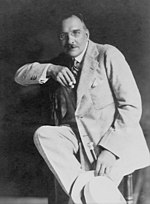Wilfrid Voynich
Wilfrid Voynich | |
|---|---|
Michał Habdank-Wojnicz | |
U.S.A. | |
| Nationality | Polish |
| Occupation(s) | Revolutionary, antiquarian book dealer |
| Known for | Discovery of the Voynich manuscript |
| Spouses |
|
Wilfrid Voynich (born Michał Habdank-Wojnicz; 12 November [
Life
Michał Habdank-Wojnicz was born in the town of
He attended a

In 1885, in
.Whilst in Siberia, Voynich acquired a working knowledge of eighteen different languages, albeit not well.[6][7]
In June 1890 he escaped from Siberia and travelling west by train got to Hamburg, eventually arriving in London in October 1890.[8] Under the assumed name of Ivan Kel'chevskii at first, he worked with Sergius Stepniak, a fellow revolutionary, under the banner of the anti-tsarist Society of Friends of Russian Freedom in London.[9] After Stepniak's death in a railway crossing accident in 1895, Voynich ceased revolutionary activity.
Voynich became an antiquarian bookseller from around 1897, acting on the advice of Richard Garnett, a curator at the British Museum.[10] Voynich opened a bookshop at Soho Square in London in 1898. He was remarkably lucky in finding rare books, including a Malermi Bible in Italy in 1902.[7]
In 1902 he married a fellow former revolutionary,
Voynich opened another bookshop in 1914 in
He became deeply involved in the antiquarian book trade, and wrote a number of catalogues and other texts on the subject.Voynich relocated his London bookshop to 175
Voynich died at Roosevelt Hospital in New York, in 1930, of lung cancer.[13]
Voynich manuscript
The most famous of Voynich's possessions was a mysterious manuscript he said he acquired in 1912 at the Villa Mondragone in Italy, but first presented in public in 1915.[14] The book has been carbon-dated, which revealed that the materials were manufactured sometime between 1404 and 1438.[15] He owned the manuscript until his death.
See also
- List of Poles
References
- ^ a b Деятели революционного движения в России: Био-библиографический словарь: От предшественников декабристов до падения царизма: [В 5 т.]. - М.: Изд-во Всесоюзного общества политических каторжан и ссыльно-поселенцев, 1927-1934. Entry on Voynich Archived 27 March 2020 at the Wayback Machine
- ^ "Wilfrid Voynich - The Voynich Manuscript". Wilfrid Voynich. Archived from the original on 7 July 2019. Retrieved 5 March 2019.
- ^ Katz, Brigit. "Here's What You Need to Know About the Mysterious Voynich Manuscript". Smithsonian. Retrieved 5 March 2019.
- ^ a b Colin MacKinnon (2013). "The U.S. Bureau of Information File On Wilfrid Voynich" (PDF).
- ^ a b René Zandbergen (2017). "H. Wilfrid Michael Voynich".
- PMID 9156466.
- ^ a b "Mr. W. M. Voynich." Times [London, England] 22 March 1930: 17. The Times Digital Archive. Web. 10 April 2017.
- ISBN 978-1-78205-185-5.
- JSTOR 26409690. Archived from the original(PDF) on 5 October 2016. Retrieved 3 February 2010.
- ^ The Library World Vol 34 Issue 9
- ^ Duffy, Eamon (20 April 2017). "Secret Knowledge—or a Hoax?". The New York Review. Retrieved 23 October 2017.
- ^ "The bookseller : a newspaper of British and foreign literature". London : [s.n.] 23 October 2017. Retrieved 23 October 2017 – via Internet Archive.
- ^ Colin MacKinnon (2013). "Wilfrid Michael Voynich's Certificate of Death And Grave Site" (PDF). Archived from the original (PDF) on 12 June 2015. Retrieved 23 October 2017.
- The Buffalo Evening News. 9 December 1915. p. 21. Retrieved 4 April 2020 – via Newspapers.com.
- ^ Goldman, Eleonora (20 April 2017). "Russian scholars unlock the secret of the mysterious Voynich manuscript". Retrieved 25 August 2018.
The manuscript is an illustrated medieval codex written by an unknown author between 1404 and 1438.
